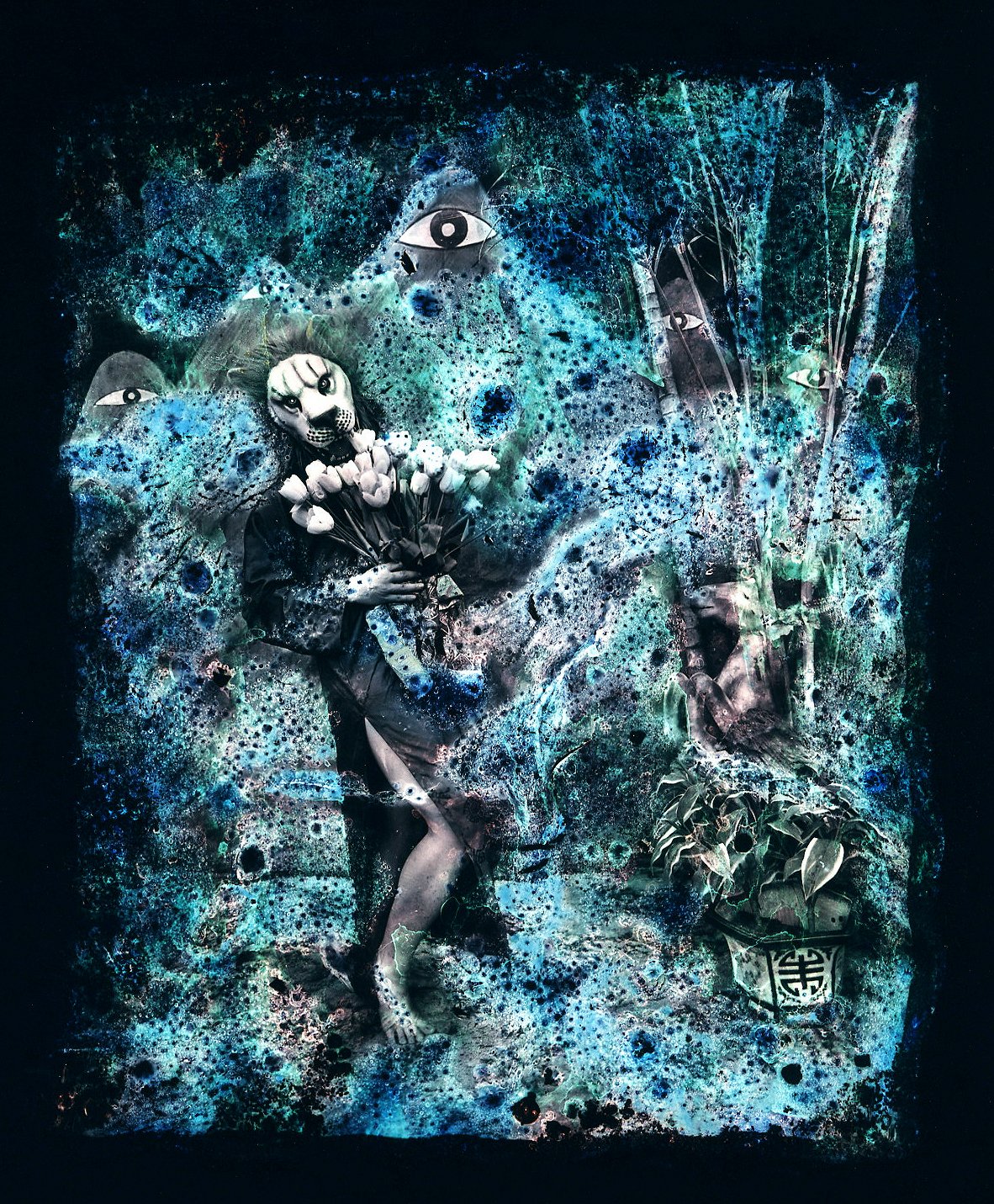Rampant Beasts 1998-2002
野獸橫行 1998-2002
Staged Photography, Social Reflection – A Study of Yang Shun-Fa's Photographic Art
by Stone Lee
*Published in the exhibition catalogue of Rampant Beasts, Kaohsiung Museum of Fine Art, 2002
Young artist Yang Shun-Fa, an employee of China Steel Corporation, has been involved in photography for many years. He frequently collaborates and exchanges ideas with a group of artists from the Xiaogang area in Kaohsiung. Over time, he has developed a distinctive personal style that has garnered increasing attention and recognition within the art world.
Yang is particularly known for his "staged" photography approach. He often incorporates elaborate props and masks, transforming his subjects into characters who enact scenes under his direction. These performances are then captured through his lens. His recent works frequently depict human figures with animal heads—such as tigers, deer, and horses—dressed in various outfits, including police uniforms, military attire, or clothing of the elderly. Whether sitting, standing, or caught in confrontation, these characters come together to create a contemporary Taiwanese " Ukiyo-e" (pictures of the floating world)—part social commentary, part cautionary tale.
A signature piece in the [Rampant Beasts] series features a jungle setting where a deer-headed man grips a bottle of Rémy Martin cognac, seemingly poised to strike a sheep-headed woman who lies on the ground, possibly about to be assaulted. Nearby, a tiger-headed figure wearing a police hat observes the scene indifferently, without intervention.
Yang Shun-Fa’s work invites interpretation from multiple angles, which I will deliberate below.
1. What is used to express these "plays"?
Yang Shun-Fa puts significant effort into making his work both clear and impactful. He carefully designs or selects the right "setting" to create fitting backdrops for the "plays" he directs, which helps strengthen the meaning and overall effect. Sometimes, Yang uses props and masks he collected, other times he looks for pre-existing scenes. His main focus is always whether the chosen setting enhances the essence of the "play."
Yang also uses symbols such as "liquor bottles," "a woman's open legs," and "fingers covering eyes" to communicate his ideas. These symbols, combined with carefully chosen gestures, poses, and facial expressions, help him express his message more effectively through still images.
Additionally, Yang applies specific techniques in photo production, such as using different tones to distinguish the background from the main subject during the photo development process, or allowing the background tone to subtly seep into the main subject—both of which add a distinctive touch to his work.
2. What do these "plays" express?
Yang Shun-Fa’s works feature a wide range of backgrounds, props, and characters, which he uses to realize various "plays." These plays all point to a common theme: "the reality of contemporary Taiwan" (or Taiwan’s modern-day "floating world"). Concepts like "reality," "floating world," "cautionary images," and "songs of warning" all reflect observations of social phenomena during specific times, focusing on revealing the "true face of society" behind its artificial appearances. Through the many "plays, Yang expresses what he perceives as the "reality of contemporary Taiwan." This reality is made up of numerous phenomena that constantly occur in Taiwan, some of which may be harsh, exaggerated, outdated, violent, or crude. Beneath the superficial image of the "beautiful island," Yang’s "Taiwanese reality" might very well represent the real truth.
When a Taiwanese person faces reality with honesty, Yang’s interpretation might just be the most accurate reflection of the current situation. Revealing this truth about Taiwan’s present condition seems to be the main objective behind Yang’s creative efforts.
As a blue-collar worker at China Steel, Yang combines hard work with a deep, thoughtful observation of Taiwanese society. He expresses his findings in an innovative way, drawing inspiration from everyday life and using a personal approach to convey his message, making him a sincere observer of contemporary Taiwan.
編導攝影 社會反影──楊順發攝影藝術解讀
李俊賢 著
(收錄於2002年高美館《野獸橫行》-楊順發個展 展覽專輯)
青年藝術家楊順發為中鋼公司員工,從事攝影創作已有多年,經常和一群小港地區藝術家討論研究,近年來漸漸發展出個人風格,頗受藝術界注意,評價上也頗受肯定。
楊順發的創作最受肯定的應是它「編導式」攝影手法,楊君常用各式道具面具裝扮人物,並且由這些經過「變裝」的人演出一些楊君導演的「戲」(?),再將這些「戲」拍攝下來。它近期的作品常常是一些虎頭、鹿頭、馬頭等獸頭人身的角色,穿著警察、老人、軍人等服裝,或坐或站或彼此相鬥,共同演出當下台灣的現世「浮世繪」(或警世、醒世劇)。例如在叢林背景中,鹿頭男人手握著「人頭馬」甘邑(法國名酒)酒瓶,做勢要擊打倒臥在地,可能將被強暴的羊頭女人,而在不遠的地方,有一個虎頭戴警察帽子的人,正袖手旁觀。所以;解讀楊順發的攝影藝術,可由以下幾個層面著手:
用什麼表達了這些「戲」?
為了清楚表達,使作品達到目的,楊順發可說頗費苦心。就作品意涵的情境鋪陳手法而言,楊順發必須設計或尋找「場景」,以便於它所編導的「劇」有合情合理的背景,並且強化「劇」的說服力。在這方面,楊順發有時以他到各地收集的面具、道具經過有意的佈置而完成;有時則到各地去尋找「現成」的場景。不管是經由設計佈置或外出搜尋,是否完整呈現「戲」的精神、強化「戲」的內涵,應該是其最大的關心重點。當場景確立選定,佈景道具選擇完成,各種角色就在楊順發完成的「場景」中,照著在楊順發的構想「演戲」。為了強化所欲表達的內涵,使訊息傳達的更清晰,楊順發很擅長使用「符號」闡述意念,經由一些諸如「洋酒瓶」、「女人張開的雙腿」、「女人的肚兜」、「古畫」、「掩眼的手指」等具有特定意涵的「符號」,楊順發清楚明確的表達。因為最後楊順發是以靜態的圖像作為呈現媒體,用具有清楚「符號」意涵的道具、手勢、姿勢、五官等「演戲」表現,確實更能清楚有力的傳達作者的原意。
此外,楊順發在實務製作上,也有一些頗特別的做法,如沖洗照片時背景和主景在色調上加以區隔,以及把背景色調局部滲透至主景的做法,都是相當特別的。
2. 這些「戲」表達什麼?
楊順發的作品有各種背景、道具、角色、並藉此演出各種「劇」,各種形形色色的「劇」,幾乎都指向了一個共同的意義、情境──「台灣現世相」(或當下台灣浮世繪),所謂的「現世相」、「浮世繪」、「警世圖」、「勸世歌」等,都是各種時代對當時的「當下」各種社會現象的觀察,而主要著墨在虛矯的表象之下的「社會真面貌」。楊順發經由許多「親手」編導攝製的「戲」,表達他所觀察體驗到的「台灣現世相」,那是隨時隨地發生存在於台灣的各種「現象」,這些「現象」或許是不堪、浮誇、陳腐、殘暴、粗俗----的,在虛矯的「美麗寶島」表象之下,楊順發的「台灣現世相」或許才是真實的真相,當一個台灣人真誠的面對現實,楊順發的「台灣現世相」容或是真實的真相,而披露台灣當下現實真相,應該是楊順發費盡心力創作的用意。
楊順發身為中鋼藍領工人,辛勤工作之餘,深刻觀察體驗台灣社會,並以頗具創意的手法表現觀察體驗所得,從生活中萃取創作資源,用很個人的語言傳達出來,是台灣當下現象的真誠觀測表現者。












